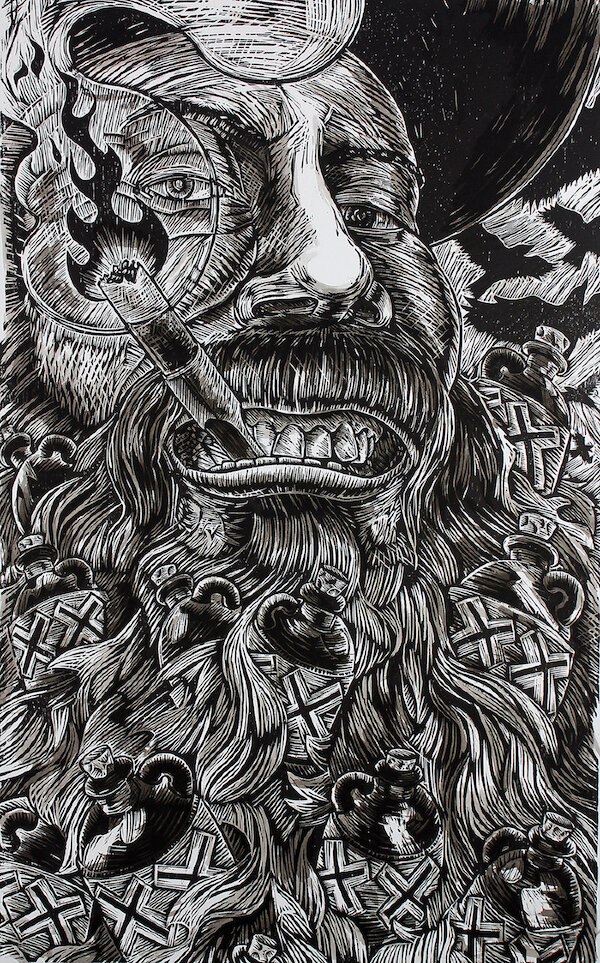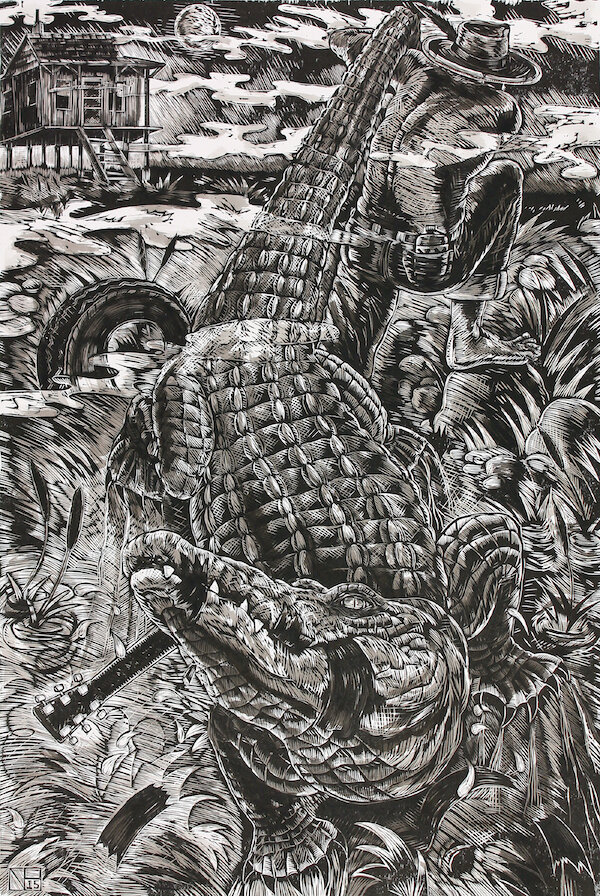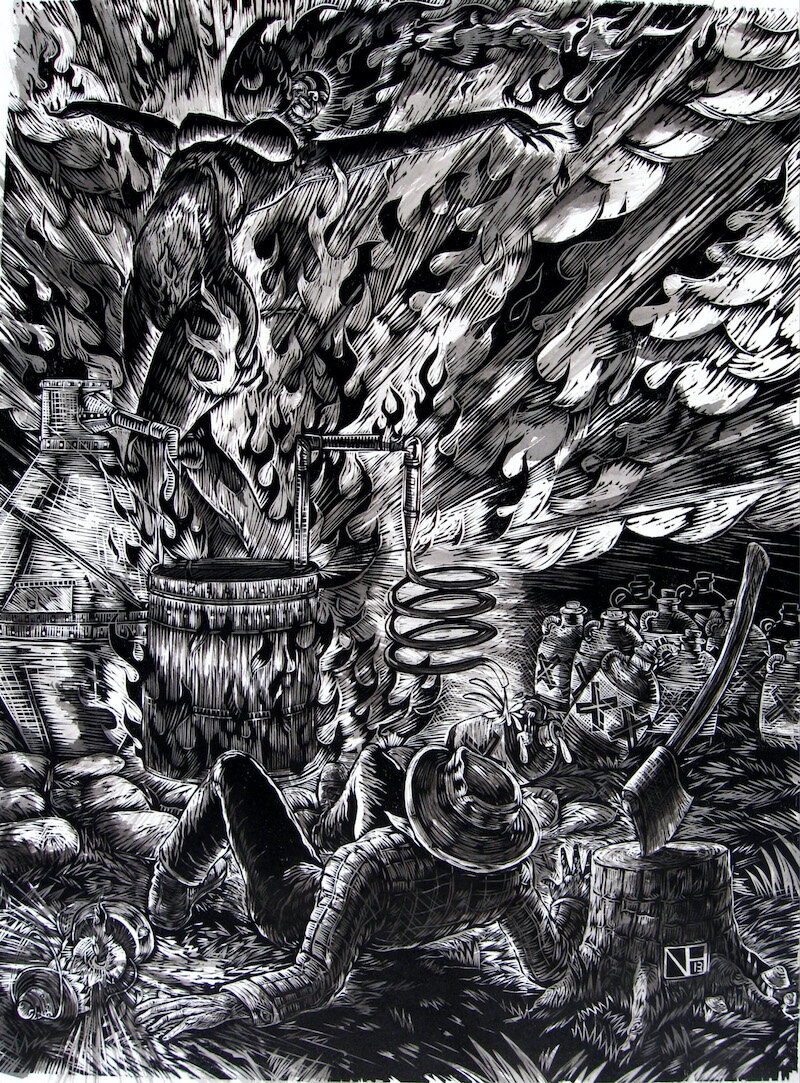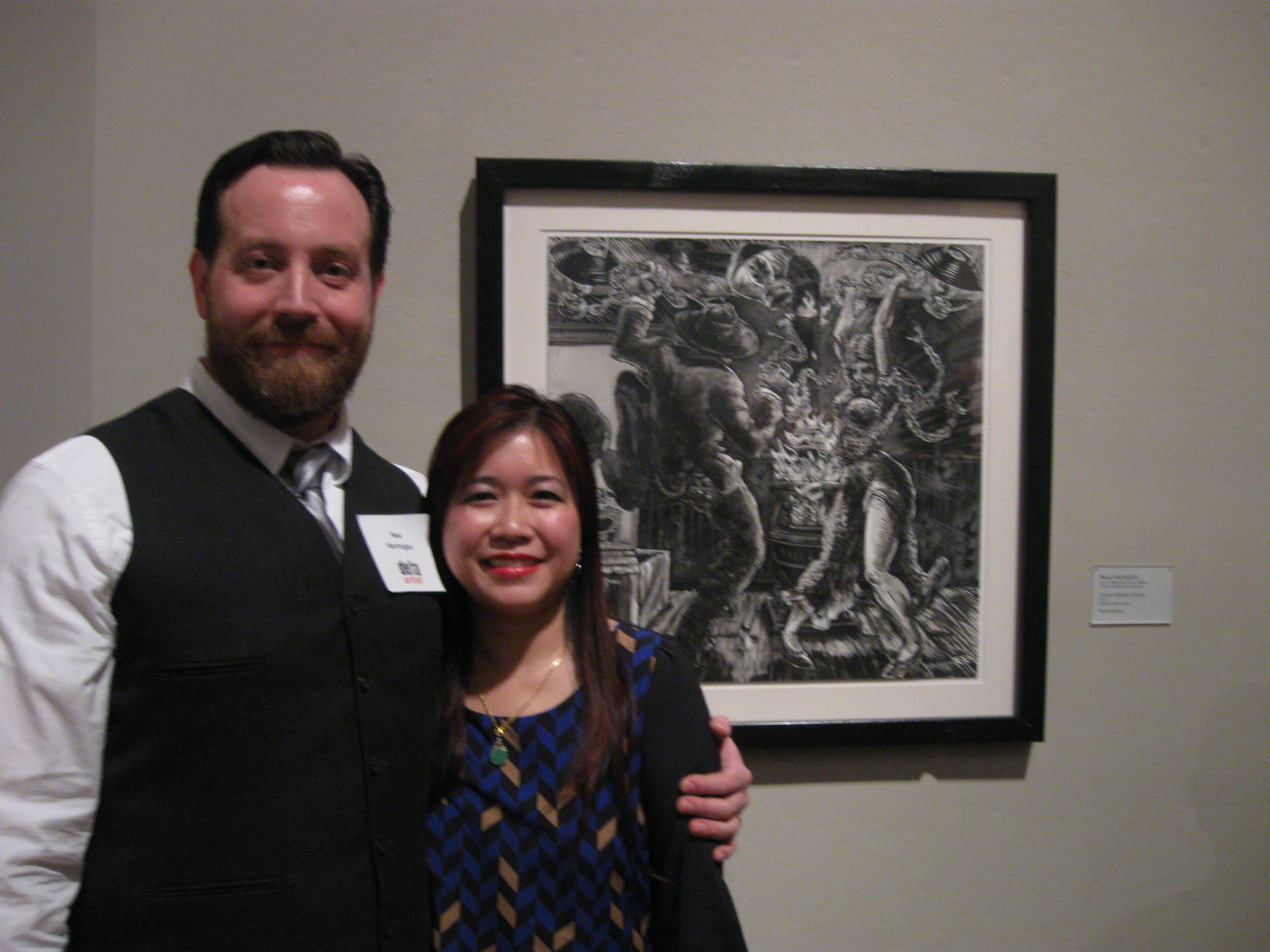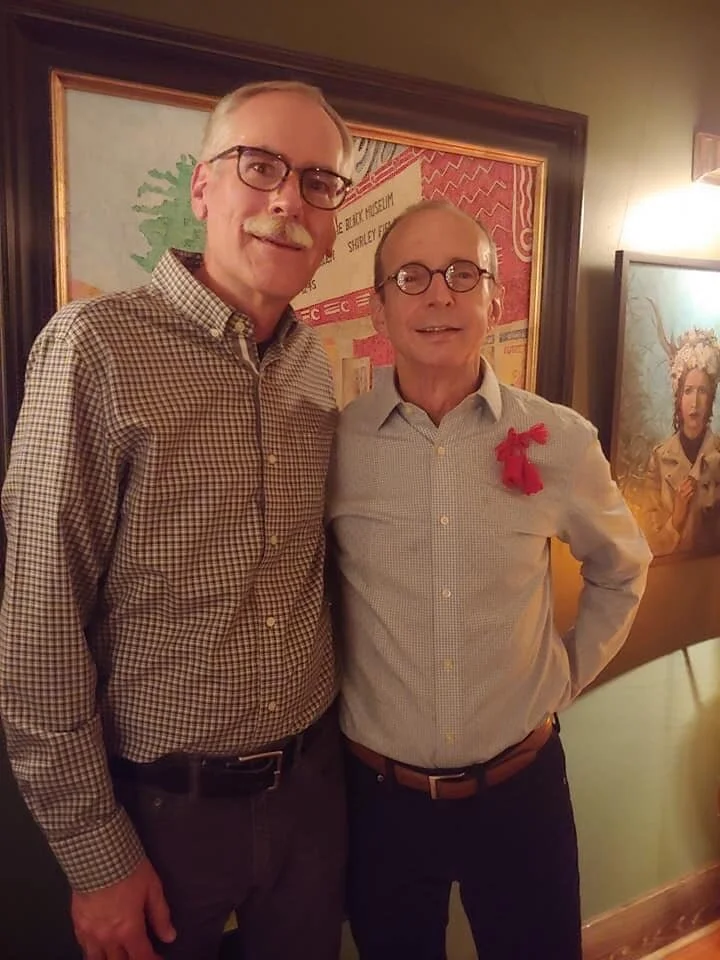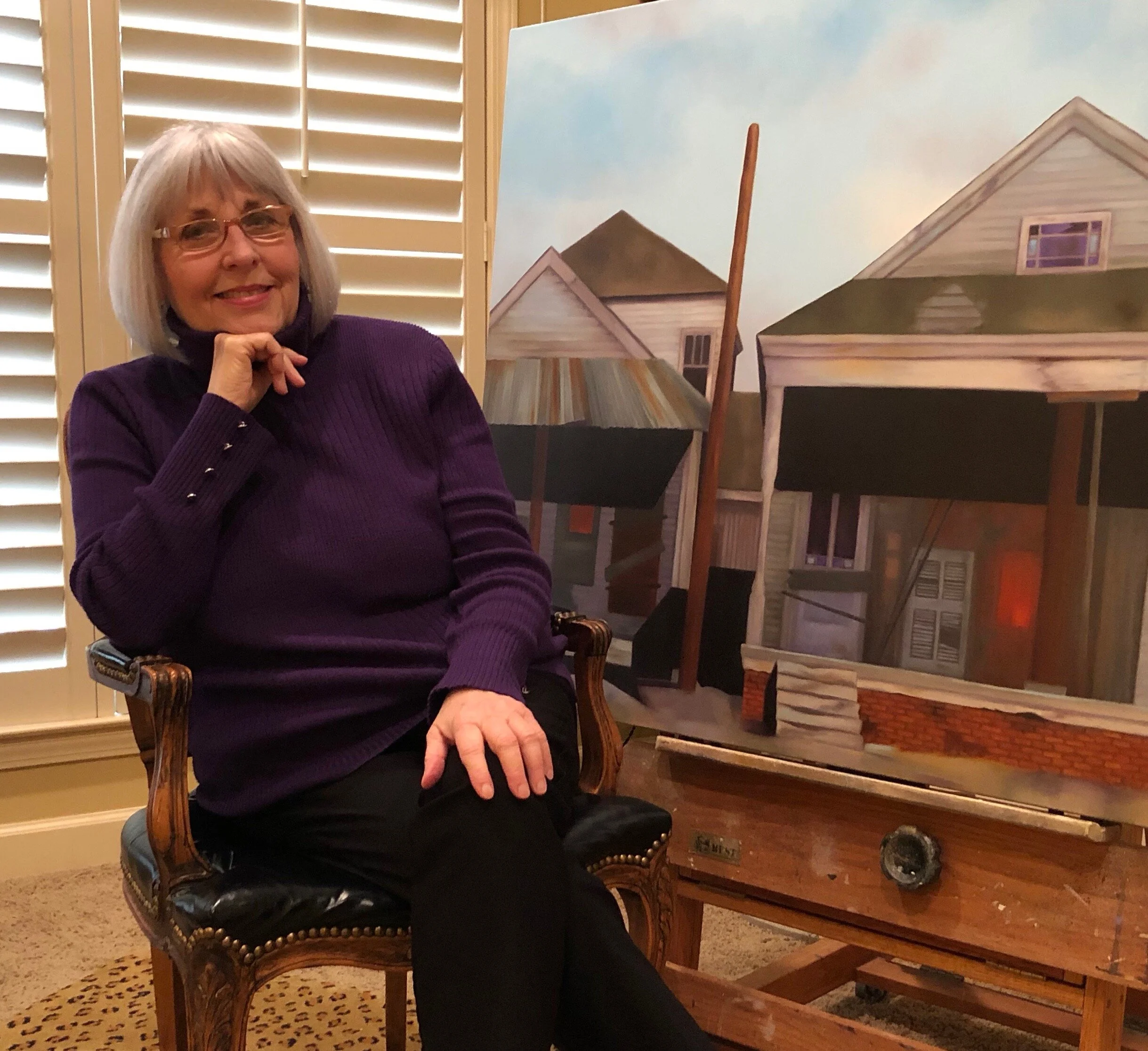Interview with artist/teacher Neal K. Harrington
Neal K. Harrington was born in Rapid City, South Dakota. In 1998 he earned a BFA in Fine Arts with an emphasis in drawing and painting from the University of South Dakota, then earned an MFA in Fine Arts with emphasis in printmaking from Wichita State University. Neal and his wife Tammy Harrington, also an accomplished artist (and Art Professor at the University of the Ozarks), live in Russellville, Arkansas, where he is Professor of Art and director of the Norman Hall Gallery at Arkansas Tech University. Neal’s work is available at M2 Gallery in Little Rock and through his website, Facebook and Instagram pages. His photo is courtesy of Kat Wilson.
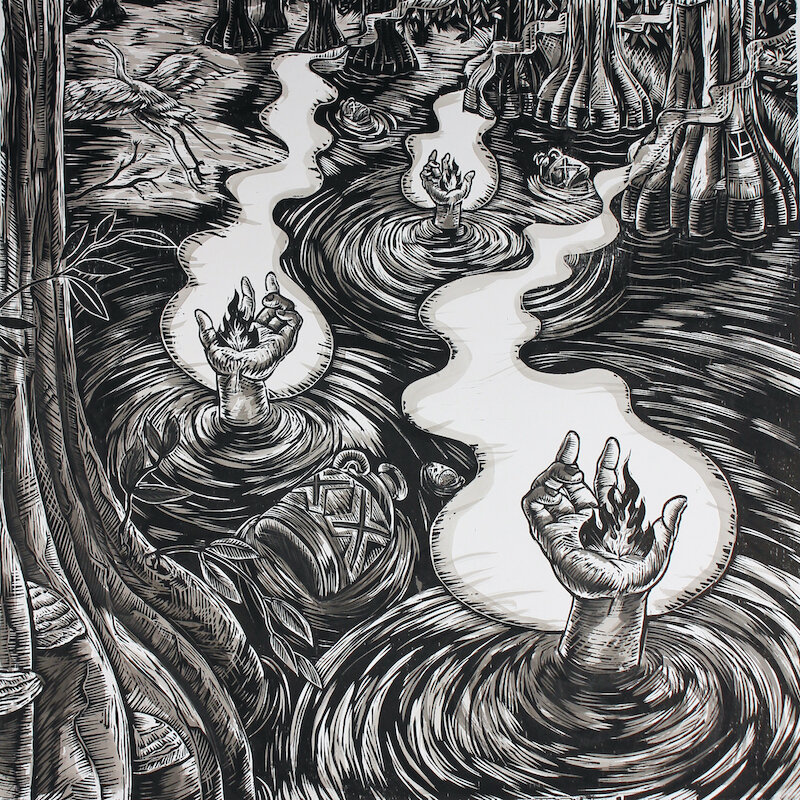
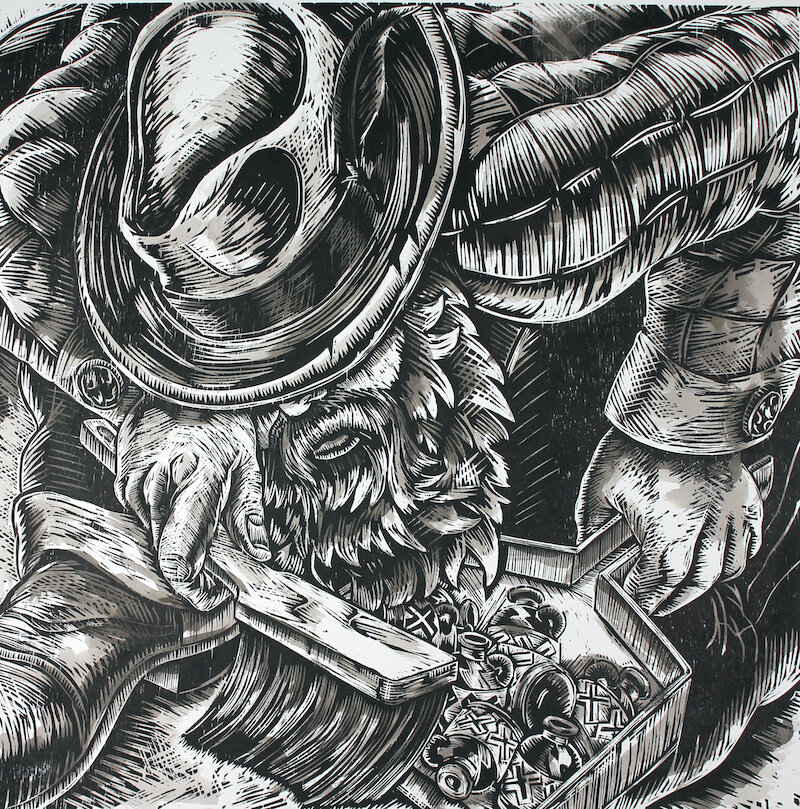
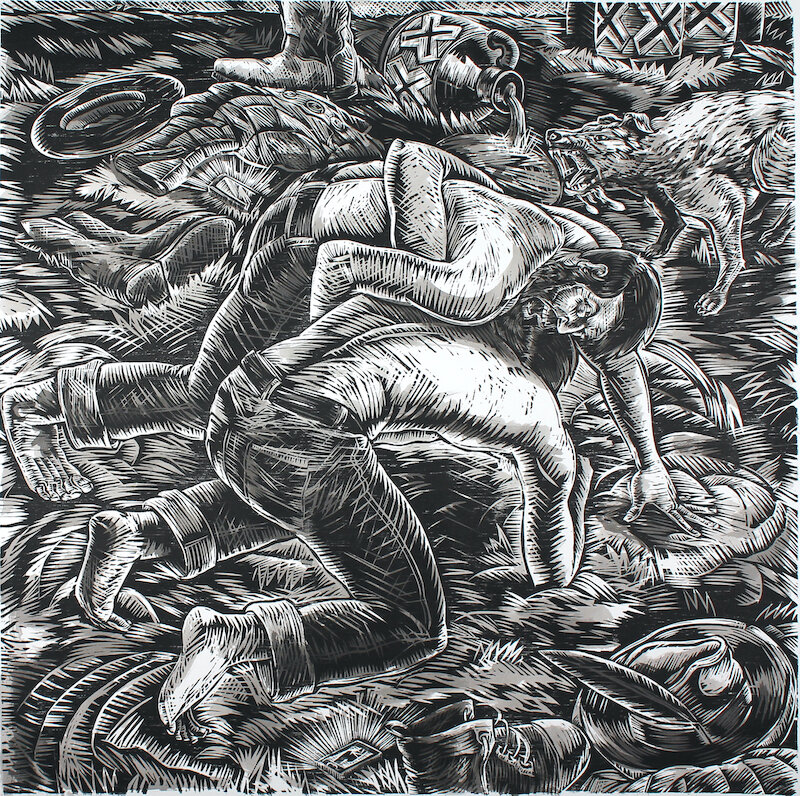
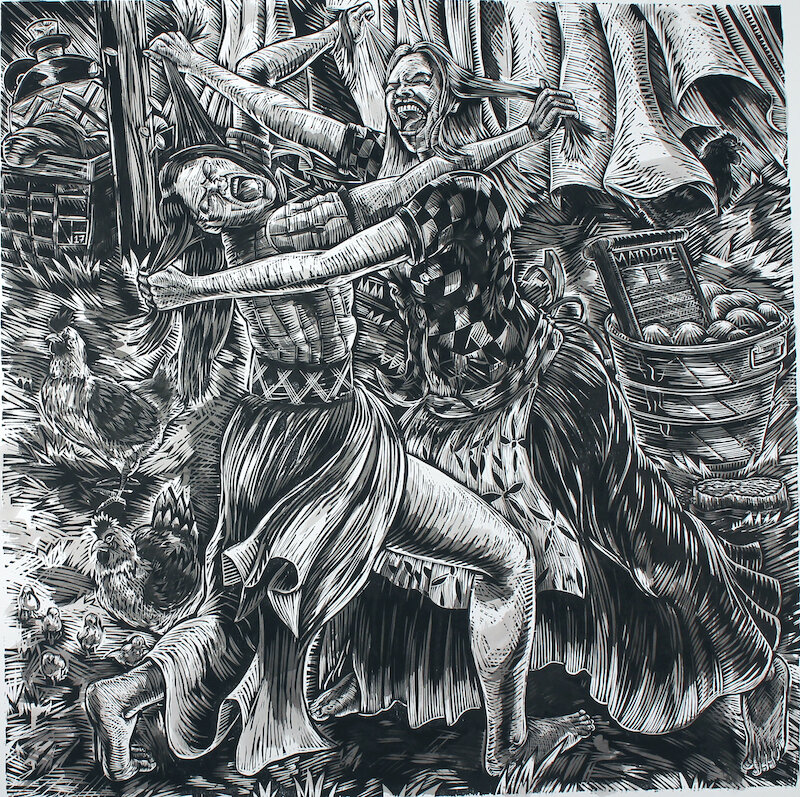
AAS: Neal, let’s start off with your background. You grew up in the “frigid north” of South Dakota then moved as an adult to Wichita, Kansas before coming to Russellville. How did all of this happen?
NH: Yep, I grew up in the shadow of Mt. Rushmore…it is not far from my hometown of Rapid City, SD, about 20 minutes. This area is very touristy, in addition to Mt. Rushmore, there is gambling in historic Deadwood (Wild Bill Hickock was shot there) plus a huge biker rally in Sturgis. It is a beautiful place to grow up although I could not wait to leave! Ha! The area has more appeal now that I am an adult.
I had a few misadventures at different colleges before settling in at the University of South Dakota. Even though the school is in a small town, USD had a really great art program, all the professors were outstanding (and interesting characters to boot). I met my wife in an art class. We were graphic design majors, after much soul searching, I wised up and switched to painting which was a better fit for me.
Graduate school was the next step, but I didn’t have any luck with the programs that I applied to. Tammy had an opportunity at the Wichita State University program, in Wichita, KS. The Printmaking professor offered her a graduate position right on the spot and she wanted to go. We were already married at the time so I tagged along and applied to the painting program and was also accepted into the graduate school. Now we live in Russellville, Arkansas. Tammy is a Professor of Art at the University of the Ozarks in Clarksville.
AAS: Were you always interested in art – even as a child? Did you grow up around art and artists?
“I have always been a dreamer. I daydream best in meetings, math class…”
NH: I definitely did NOT grow up around artists. Like most kids, I enjoyed the very few cartoons that were on after school and on Saturday mornings. That was the extent of my art exposure as a kid! I was always drawing, like most people when they are kids. I don’t think I’ve met too many people that didn’t draw as a child. I just never got bored with it. Drawing was never easy for me. I had many friends that drew much better than me, but they didn’t stick with it and most of them don’t draw or make art now. I liked the challenge and maybe that’s what kept me going. I had never been to an art museum or gallery until I was in my 20’s. The only other art exposure I had was comic books. The local gas stations and grocery store had magazine racks with their random assortment of comic books. This was my art museum. I would buy comic books and copy from them. I enjoyed drawing the covers most of all.
Sole Food, woodcut / India ink washes, 32” x 24”
AAS: Your interest in printmaking was cultivated at Wichita State. What ‘drew’ you to printmaking.
NH: My complete confusion/failure in the painting program! Let’s just say, I didn’t quite mesh with the painting professors at WSU. I was turning out lots of paintings (traditional and experimental), winning awards, exhibiting in competitions and they just did not understand my “aesthetic”. I was frustrated with the process, the faculty could not express or communicate to me what I needed to work on to improve, the advice was so confusing and vague. I worked hard, made lots of paintings, and was open to criticism (as much as the next insecure young artist). The advice I received consisted of “your paintings are glib” and “you rely on line as a crutch”. I didn’t even know what “glib” meant. When I asked the professor to explain to me how this advice helped, and what can I specifically do to improve, he stood up, said that we were done and left my studio. I was at a loss. That was it. I was done. My wife suggested that I might try to switch to printmaking since there was going to be an open grad spot. I did. It was the best and hardest thing ever. I had to maintain my commitments to the painting professors as a Teaching Assistant for the upcoming semester, take a full load of courses, assist the printmaking professor, and learn ALL the printmaking techniques that I was not as familiar with so I could teach the Intro to printmaking course to freshmen in the spring. It was very overwhelming but I buckled down and did it. That experience taught me a lot about how to teach and how not to teach.
Once I learned the printmaking techniques I really became infatuated. I loved to draw and paint but that was all I had known prior to college. Tammy was instrumental in teaching me from the ground up. I re-learned Intaglio (etching with many different techniques that can be used to create an image), Relief (woodcut and Linoleum cut), Lithography, Collagraphy, Paper Making, and Book Making. On top of that had to brush up on how to edition hand pulled original prints and the variety of papers and materials to work with. Switching to printmaking was the best thing that ever happened to me creatively and professionally. I became a much better artist and was more ready for a career in the arts. As frustrated as I was in the painting program, I used it as a positive incentive and the printmaking professor John Boyd was truly my first mentor in this profession, as an artist and art educator. I owe him a lot. Coincidentally, he spent most of his early life in London, Arkansas!
“Printmaking was the best thing that ever happened to me creatively and professionally. I became a much better artist and was more ready for a career in the arts.”
AAS: In preparing for this interview, I finally learned the differences between the different types of printmaking - relief and intaglio printing, for example. Talk about the different techniques you use and what each offers to you.
NH: Printmaking allows you to experiment with different techniques that are still mysterious and surprising to me today and I still find exciting. I have been in the printmaking game for almost 20 years now and I feel like I am just scratching the surface (print joke!). My process removes a bit of the spontaneity that I had when I was a painter. There were times I would start out with one concept and the result would be something completely different. If I don’t plan the print out ahead of time, the piece rarely works out. With paintings I would just make it up as I went along. I still have some flexibility with prints but it happens in the planning stages. I address all the print processes that way. I work out the content and composition early on then commit and execute it. Sketchbooks are where I store all my ideas, otherwise I forget them. The sketchbooks contain fully rendered drawings but sometimes it’s a just word or a doodle.
I was drawn mostly to Relief (woodcuts and linoleum) due to the availability to create the block anywhere. Most print processes require ventilation, chemicals, and other solvents. Relief blocks can be carved while sitting at the kitchen table! Plus, I am drawn to the graphic quality and appearance, they really lend themselves to storytelling.
AAS: You may be best known for your printmaking; however, you are producing some wonderful drawings in ink with washes. You create wonderful depth and even soft texture with your washes. Where did this technique come from?
“Drawing was never easy for me. I liked the challenge and maybe that’s what kept me going.”
NH: Thanks! I learned the India Ink wash technique as an undergrad at USD. I loved it right away, it was the perfect combination of drawing and painting. What’s not to love?! Plus, it brings the spontaneity back to my process. I haven’t seen anyone that combines woodcut with ink washes, but I’m sure there must be some. I am heavily influenced by Lynd Ward, Luis Jiménez, and Robert Crumb. All very skilled figurative artists that not only use details but inventive compositions to express their vision.
AAS: You don’t seem to take yourself too seriously, at least in your art. Your woodcut series The Bootlegger’s Ballad is powerful and whimsical and at the same time incredibly complex — and you appear in several of them. Talk about the series and the techniques used to create it.
NH: I was influenced by how artists incorporated figures into compositions. The underground comic artist Robert Crumb and Arkansas’ own Warren Criswell placed their images in their art and I have always found that daring and risky. I don’t look at the character in my works as “Neal” per se. I don’t think I could make the prints. I see the figure as a timeless everyman, an Ozarks adventurer, and explorer that emulates the mythos of Southern Americana. Like I tell my wife, the character looks like me but isn’t me. I couldn’t and wouldn’t do most of the things that the character does.
AAS: Your work is mostly black, white, and shades of gray. When you look at nature or people, do you immediately see it in B/W or does that just come later when you interpret it?
NH: While I have created some color work, black and white with various shades of value is where it’s at for me…this draws me back again and again. The comics I liked best were black and white, extreme value ranges like in “The Savage Sword of Conan” and the early “Teenage Mutant Turtles” series.
“I see the figure [in the Bootlegger’s Ballad series] as a timeless everyman, an Ozarks adventurer, and explorer that emulates the mythos of Southern Americana. I couldn’t and wouldn’t do most of the things that the character does.”
Feather Signal, woodcut / India ink washes, 24” x 24”, Delta Winner 2014
AAS: You teach figure drawing, illustration and printmaking at Arkansas Tech. Which is the most popular with the students?
NH: These courses are all required by various art curriculum so I do have to teach them regularly. I would love to say that my incredible teaching methods draw them in but to be honest, the students have to take the classes either way. I teach all of these courses a bit differently based on the class. Figure drawing is very straight forward, we work on scale and proportion; there really is a right and wrong answer in figure drawing anatomy. We see figures every day and it is very apparent if something isn’t correct. Students are taught to draw what they SEE not what they KNOW. The process is called sight drawing and it is based on comparing areas on the model and where they interact visually. The drawing should match what you see. If the model’s foot is located a certain distance/placement from the head, then it should be the same on the drawing of the figure. The real secret to drawing is PRACTICE.
Printmaking is tied into many techniques and processes that are different from anything that young artists have tried before so I concentrate mostly on that. The content and imagery is left up to each individual person to decide. I help with these concepts but really I am trying to build the technique. Illustration is a higher level course. The students have had a ton of studio classes by that point in their college career so the concentration is on developing content and composition in order to best transmit the visual story to the viewer in new and interesting ways.
AAS: You are also director of the Norman Hall Gallery. The gallery must be a great opportunity for students to learn from professional artists as well as to have the opportunity to exhibit their own work to the public. That must be an eye-opening experience for them. How have students felt when they see their works on display?
NH: The gallery is a great teaching tool. We have 3-4 professional artist exhibits each year. A reception/artist talk (with the exhibiting artist) is held during the day and we get a great turnout (40-60 students). Our graduating seniors exhibit each spring and that is a fun and exciting show. Lots of friends and family attend the receptions. I am really proud to have developed a juried student competition open to all ATU students (current or previously enrolled in an art class the prior semester). This is a real world experience and not every piece entered gets into the show. A different juror is selected for the show each year and the juror is a professional in the art world, usually a professional artist, art educator, and/or gallery owner, etc.
Snake Shaker’s Shack, woodcut / India ink washes, 24” x 24” - 2013 Delta Award Winner
AAS: You regularly exhibit nationally in juried exhibitions and have won many awards including two Delta Exhibition Awards at the Arkansas Arts Center. Comment on your experiences in these juried exhibitions. Other than a prize, what can artists take away (learn) from these events?
NH: When you are starting out, nobody is calling you to see your work. Entering shows is needed to get your artwork out there. Although, I feel that the way we view art is changing. With the juried show route, an artist will pay $25 - $50+ dollars to enter. If you are lucky enough to get in the show, the artist is typically responsible for paying shipping to and from the exhibit or delivering the artwork. If you are fortunate to sell the work at the show, the venue can take as much as 50% commission. I encourage students to pick the shows they enter carefully. You are making an investment in advertising at that point. I wish I had a lot of that money back that I spent, especially if I didn’t get in the show! Ha! So much exposure is now digital and online. Create a website, use Instagram or use Facebook to get your work out there. Connect with other artists. I worked really hard at getting my work out to the world and it can be overwhelming. I still enjoy making things so I have to take solace in that. If I didn’t teach, I could not survive on art sales. This profession frees me up to make whatever art I want without worrying about sales.
AAS: Your work is collected by a number of museums and private art collectors. Does this give you any special satisfaction or is just creating the work and getting it out to the public enough?
NH: Obviously any attention is flattering. I am happy people like what I do. My life is fantastic, I landed a job in art that I love and I have a great family (married 23 years this coming August). Art sales and shows are icing on the cake.
Tammy, is my biggest supporter and most honest critic. She has made suggestions on every successful work I have produced. Did I always take the suggestion? Maybe, Ha! It is good to get feedback even if I don’t always use it. I venture that this is the case with lots of her works as well!
AAS: Do you have an upcoming series planned?
NH: Just to keep this Bootlegger’s series going until it gets stale. I have been doing lots of commission work with half the proceeds going to friends that are out of work. It has been really fun and rewarding. I am sure that the Bootlegger’s series will run its course and it has a few times…then boom, 5-6 more ideas. I am not bored with it yet. It will tell me when it becomes repetitive…then, it’s time to move on.
AAS: Printmaking usually results in multiples of the image. How many do you generally print of a work? Do you keep one copy for yourself or are you happy with selling them all?
Neal and Tammy at the 2013 Delta Exhibition with Delta Award Winner Snake Shaker’s Shack
NH: Isn’t that great?! The perk of printmaking. Yes, I usually keep a print of the edition for myself. At first when I was a painter it was hard to trade cash for my painting. These artworks are intimate creations that you have struggled with, fought with, and looked at a million hours. Take a picture because once you sell it, it’s gone. Printmaking not only allows me to have multiple original hand pulled prints, but I can try a successful composition in different techniques/sizes/colors without getting bored. I have kept my edition size small for the last 10 years or so.
AAS: Since both you and your wife are artists, do you encourage your children to draw/paint?
NH: Our children are 16 and 13. Both drew when they were younger. Now neither of them do any art at all. I am jealous of “art parents” whose children also like to make art (looking at you Jason McCann!). We force them to attend the art museum in every town we go to. It is fine that they are not into what we do. Tammy and I encourage them to be their own people. My daughter has found her creative outlet in makeup, she’s pretty good at it and she does some pretty elaborate effects.
Life is so busy, mostly we try to have mealtimes together. We are at the point in our family life where the kids are involved in tons of extracurricular activities so really it is driving from one game or event to another and supporting them. We play board games, watch movies, and then there’s always general tomfoolery!
